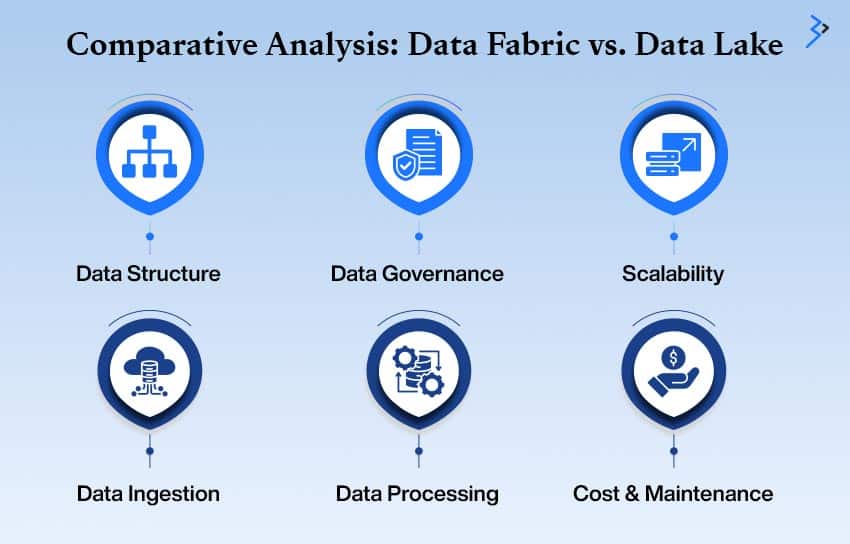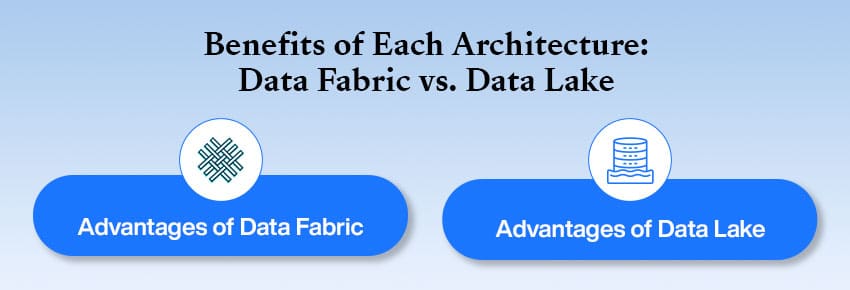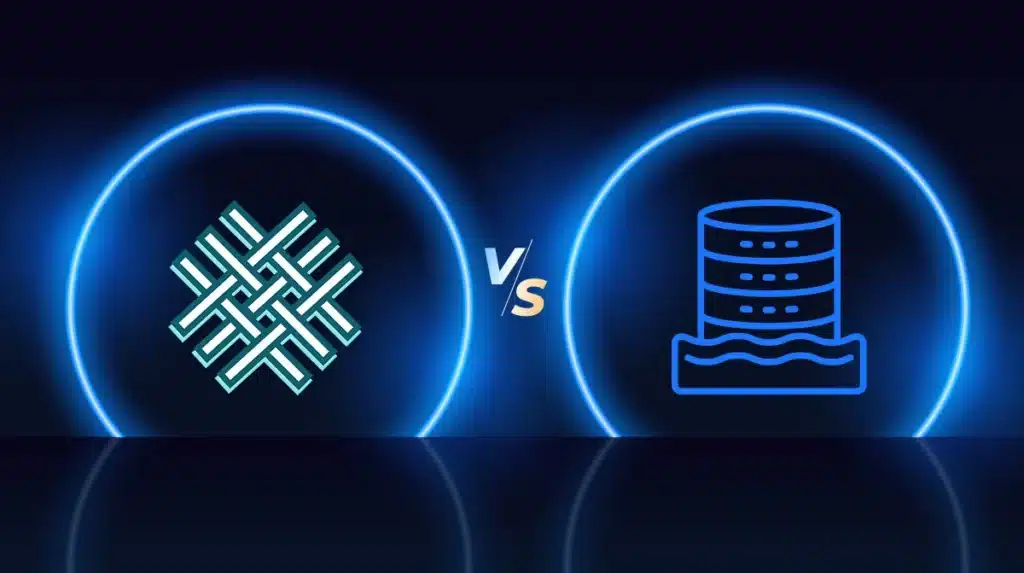Data is everywhere—flowing in from apps, websites, sensors, and countless business systems. For enterprises, this means more than just storage headaches; it’s about making that data work for the business. As volumes grow and sources diversify, companies need more than traditional databases. They need smart, scalable strategies that ensure quick access, ironclad security, and real-time usability.
That’s where Data Fabric and Data Lake come in—two powerful yet distinct approaches to modern data management. With our data analytics and consulting services, each solution offers a unique way to store, organize, and analyze data depending on your organization’s needs. Data Lakes are great for raw storage and deep analytics, while Data Fabric connects and enriches data across silos, making it accessible and trustworthy wherever it lives.
But how do you choose the right one? Or is there value in using both? In this blog, we’ll demystify each architecture, highlight its key advantages, and explore when and why it shines in real-world business scenarios. Understanding these options is a smart place to start if your organization wants to unlock insights, drive innovation, and future-proof its data strategy.
Understanding the Architectures
To choose the right data strategy, it’s essential to understand the core architectures behind it. Data Lake and Data Fabric represent two distinct approaches to managing and utilizing data. Let’s break down each architecture, how it works, and where it fits in the modern data landscape.
What is a Data Lake?
The term “Data Lake” refers to a consolidated repository that may hold large volumes of unprocessed data in its original form. Big data analytics and machine learning applications benefit greatly from their ability to accept organized, semi-structured, and unstructured data. With our machine learning services, data lakes provide scalability and flexibility by storing data without imposing a preset structure. This allows companies to absorb data from different sources without immediately transforming it.
What is a Data Fabric?
Data Fabric is an architectural approach that provides a unified framework for data management across disparate sources and environments. It integrates data from multiple platforms, ensuring consistent data governance, quality, and accessibility. By leveraging metadata, machine learning, and automation, data fabric facilitates real-time data integration and analytics, enabling organizations to derive insights more efficiently.
Comparative Analysis: Data Fabric vs. Data Lake

| Parameter | Data Fabric | Data Lake |
| Data Structure | Integrates data from multiple sources, providing a unified view. | Stores raw data in its native format without predefined schemas. |
| Data Ingestion | Handles both structured and unstructured data with transformation capabilities. | Optimized for ingesting large volumes of raw data from diverse sources. |
| Data Governance | Offers robust governance, ensuring data quality and compliance. | Requires additional tools for comprehensive governance and quality checks. |
| Data Processing | Supports real-time analytics and automation through metadata and ML. | Suitable for batch processing and advanced analytics on large datasets. |
| Scalability | Scales horizontally and vertically across hybrid environments. | Designed for horizontal scaling to accommodate growing data volumes. |
| Cost & Maintenance | It may involve higher initial costs, but it reduces long-term maintenance efforts. | Cost-effective for storage, but may incur additional processing and governance costs. |
Benefits of Each Architecture: Data Fabric vs. Data Lake

As enterprises generate and consume massive volumes of data, selecting the right data architecture becomes vital for operational efficiency, agility, and decision-making. Both Data Fabric and Data Lake offer distinct advantages that cater to different data management needs. Understanding their respective benefits can help organizations craft a tailored strategy for handling data effectively.
Advantages of Data Fabric
Data Fabric offers a modern, intelligent data architecture designed to manage data seamlessly across environments, systems, and platforms. It goes beyond mere storage by delivering accessibility, automation, and governance at scale.
- Unified Data Management: This provides a cohesive platform for managing data across various systems—on-premises, cloud, or hybrid—ensuring consistency, accessibility, and standardization.
- Enhanced Data Discovery: This approach uses metadata-driven processes and semantic layers to make data easily discoverable and usable across departments, reducing time spent searching for the right datasets.
- Real-time Analytics: Enables organizations to process and analyze data as it’s generated, supporting timely and informed decision-making that drives business responsiveness.
- Improved Data Governance: This feature embeds governance policies, data lineage, and compliance protocols directly into the architecture, ensuring high data quality, security, and adherence to regulatory standards.

Advantages of Data Lake
A data lake is a large, centralized repository that stores raw data in its original format. Their capacity to scale, adapt, and serve complex data science and analytics use cases is where they really shine.
- Flexible Storage: Accommodates structured, semi-structured, and unstructured data without requiring transformation, enabling easy ingestion from diverse sources like social media, IoT, and enterprise systems.
- Scalability: Built for horizontal scaling, data lakes can handle petabytes of data, making them ideal for high-volume environments such as IoT and real-time web applications.
- Cost-effective: It eliminates the need for preprocessing or schema enforcement at the time of ingestion, reducing operational overhead and storage costs.
- Advanced Analytics: Supports integration with big data tools, machine learning platforms, and business intelligence systems, empowering organizations to perform deep data mining, pattern recognition, and predictive modeling.
When to Use Each Architecture
Choosing between Data Fabric and Data Lake depends on your organization’s current infrastructure, strategic goals, and data maturity level.
Use Data Fabric When:
- You need real-time access to integrated data from multiple sources
- Compliance and governance are top priorities
- Your organization operates in hybrid or multi-cloud environments
- You want a consistent view of data across business units
Use Data Lake When:
- You are handling massive volumes of raw, varied data
- You require affordable long-term data storage
- Your focus is on experimentation, data science, and ML modeling
- Real-time performance is not a primary requirement
Both Data Fabric and Data Lake play critical roles in modern data strategies. Choosing the right one—or combining both—can empower your organization to manage, secure, and extract value from data more efficiently in today’s competitive landscape.
Use Cases: When to Use Which
With the exponential rise in data volume, variety, and velocity, organizations must adopt architectures that align with their specific operational goals. While Data Fabric and Data Lake both serve as pillars of modern data management, each is designed to solve distinct challenges. Understanding their use cases can help you make the right choice—or strategically combine them for optimal results.
Data Fabric Use Cases

Data Fabric excels in scenarios where real-time data accessibility, governance, and interoperability are essential. It enables businesses to unify disparate data sources into a connected and intelligent data layer. Here are key use cases that showcase the strengths of a Data Fabric approach:
1. 360-Degree Customer View
Organizations that aim to understand their customers holistically benefit immensely from Data Fabric. Businesses can build a rich, unified customer profile by weaving together data from multiple systems, such as CRM platforms, customer support channels, sales data, and website behavior.
- Enables personalized marketing and customer service
- Improves customer retention through targeted engagement
- Provides deeper insights across the customer lifecycle
2. Fraud Detection
In sectors like banking, insurance, and eCommerce, real-time fraud detection is crucial. Data Fabric supports seamless integration of data from transactional systems, third-party sources, and behavioral analytics tools to identify anomalies quickly.
- Enhances security with real-time data processing
- Uses pattern recognition to detect suspicious activities
- Provides fast alerts for immediate action and risk mitigation
3. Regulatory Compliance
Industries governed by strict regulations—such as healthcare, finance, and retail—require robust governance frameworks. Data Fabric makes it easier to ensure compliance with standards like GDPR, HIPAA, and SOX by integrating policy enforcement at the data layer.
- Automatically enforces data privacy rules across environments
- Tracks data lineage and access for audits and reporting
- Reduces compliance costs through automated monitoring
4. Legacy System Modernization
Many enterprises are still reliant on legacy systems. Instead of costly rip-and-replace strategies, Data Fabric allows organizations to integrate and modernize these systems without disrupting operations.
- Unifies legacy and modern data sources in real time
- Enables cloud migration without compromising data access
- Facilitates digital transformation through incremental upgrades
Data Lake Use Cases

Data Lake is ideal for organizations that need scalable, flexible, and cost-effective storage for diverse data types. It enables raw data ingestion and supports advanced analytics, making it a go-to solution for data science and big data workloads.
1. Big Data Analytics
Organizations that analyze petabytes of raw data, such as financial institutions, telecom companies, and online retailers, can rely on Data Lakes to store and process this data efficiently.
- Supports batch and real-time analytics
- Integrates with frameworks like Hadoop, Spark, and Hive
- Allows data scientists to access raw data for deep exploration
2. IoT Data Management
The rise of connected devices has led to an explosion in sensor-generated data. Data Lakes can store this vast, fast-moving, and often unstructured IoT data, enabling real-time or near-real-time analytics.
- Scales easily to accommodate billions of data points
- Enables predictive maintenance and system optimization
- Improves decision-making through streaming analytics
3. Customer Behavior Analysis
Data Lakes allow businesses to analyze unstructured data, like social media posts, clickstreams, and product reviews, alongside structured datasets. By leveraging our social media marketing services, companies can gain nuanced insights into customer behavior and preferences.
- Enables personalized product recommendations
- Identifies patterns across marketing, sales, and support channels
- Enhances loyalty programs with behavior-driven segmentation
4. Log Data Analysis
IT teams often struggle with managing and analyzing logs from servers, applications, and security tools. Data Lake is a centralized platform for storing and querying log data, which is critical for troubleshooting and performance monitoring.
- Helps identify system failures and performance bottlenecks
- Supports security audits and root cause analysis
- Automates log correlation across systems
Choosing Based on Business Goals
Here’s a quick comparison to help guide your decision-making based on your organization’s priorities:
| Business Goal | Ideal Architecture |
| Real-time decision-making | Data Fabric |
| High-volume, low-cost storage | Data Lake |
| Cross-platform data integration | Data Fabric |
| Machine learning and AI models | Data Lake |
| Data security and governance | Data Fabric |
| IoT or unstructured data processing | Data Lake |
Can You Use Both? Yes!
Many organizations are now blending Data Fabric and Data Lake architectures to create a composable data infrastructure. In this hybrid approach:
- Data Lake serves as the foundation for raw data storage and advanced analytics.
- Data Fabric overlays a smart, unified layer for real-time access, governance, and integration.
This synergy allows organizations to enjoy the best of both worlds—cost-effective storage and dynamic data operations—with minimal friction.
Choosing the Right Architecture

Selecting between data fabric and data lake depends on your organization’s specific needs:
- Opt for Data Fabric if your organization requires real-time data integration, robust governance, and a unified view across disparate sources.
- Choose Data Lake if your focus is on storing large volumes of raw data for batch processing and advanced analytics.
In many cases, organizations may benefit from implementing both architectures in tandem, leveraging the strengths of each to create a comprehensive data management strategy.
Aligning Architecture with Strategy
Choosing between a data fabric and a data lake isn’t about picking a winner—it’s about matching architecture to your business goals. Data fabric excels at integration, governance, and real-time insights, while data lakes offer scalable storage and advanced analytics.
Organizations can build a hybrid or targeted approach that supports growth, ensures compliance, and unlocks valuable insights by understanding their strengths. The right strategy empowers teams to innovate faster, make informed decisions, and stay competitive in a data-driven world. It’s not either-or—it’s about using the right tool for the right job in your digital transformation journey.
Related Articles
-
Harnessing Data Insights: Power BI’s Impact on the Energy Industry
The energy sector is driven by the relentless pursuit of efficiency, sustainability, and innovation. The constant tussle to produce cleaner energy faster at scale requires analyzing enormous amounts of data.
-
Everything You Need to Know About Embedded System Programming
Introduction Embedded systems have become a significant part of people’s lives, although they are designed to operate with little or no human intervention. They are very popular due to factors
-
The SharePoint Challenge: Detail Guide To Implement and Use SharePoint
Microsoft SharePoint implementation provides a central hub for enterprise content. It’s used to access and share documents, blogs, websites, PowerPoint presentations, etc. Various SharePoint Platforms, like Power Automate, use low-code




